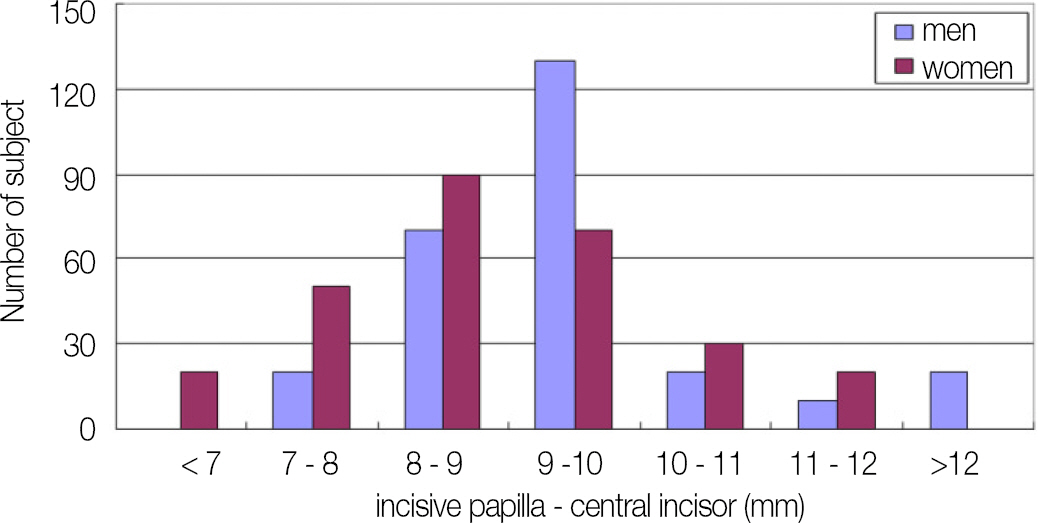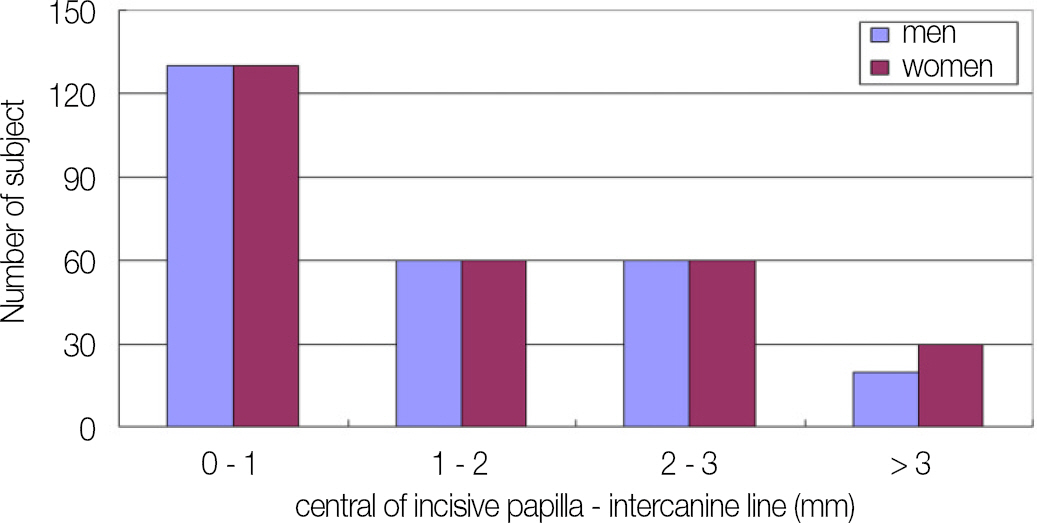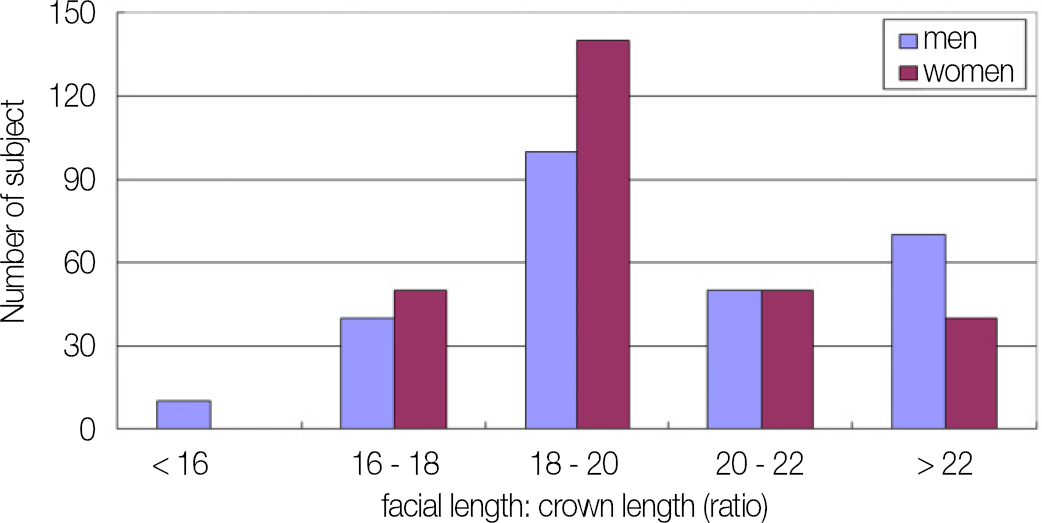J Korean Acad Prosthodont.
2015 Oct;53(4):310-317. 10.4047/jkap.2015.53.4.310.
A study on the validity of reference points for edentulous patient
- Affiliations
-
- 1School of Dentistry, Seoul National University, Seoul, Republic of Korea.
- 2Department of Prosthodontics and Dental Research Institute, School of Dentistry, Seoul National University, Seoul, Republic of Korea. silk1@snu.ac.kr
- KMID: 2118802
- DOI: http://doi.org/10.4047/jkap.2015.53.4.310
Abstract
- PURPOSE
The purpose of this study was to evaluate the validity of reference points for edentulous patient by examining the correlation of teeth and face, and intraoral anatomic landmarks.
MATERIALS AND METHODS
We examined a facial outline, length, bizygomatic width, nasion - gnathion length, glabella - nasion distance in 270 men and 280 women satisfied with inclusion criteria from Seoul National School of Dentistry. The shape of maxillary central incisor, mesiodistal crown width and length of maxillary 6 incisors, distance from incisive papilla to labial surface of maxillary central incisor, and perpendicular distance from incisive papilla to intercanine line were measured in the stone model. We analyzed the ratio and relevant relation statistically.
RESULTS
The probability on having the same shape of face and the relative same shape maxillary incisor was 55.56% and 46.43% for men and women. The facial length proved to be a more valuable measurement in women in the tooth selection. The ratio of bizygomatic width to mesiodistal width of maxillary central incisor, and the ratio of bizygomatic width to width of maxillary 6 incisors were 16.8 : 1 and 3.0 : 1 and were positively correlated with each other. The distance of the canines from the maxillary incisal papilla was 1.33+/-1.28 mm. The distance between the center of the incisal papilla and the labial surface of their maxillary central incisor was 9.23+/-1.20 mm.
CONCLUSION
It was showed that anatomical reference points in tooth selection and arrangement for edentulous patient are useful and have validity in our limited study.
Keyword
Figure
Reference
-
1. Williams JL. A new classification of human tooth forms, with spe-cial reference to a new system of artificial teeth. Dent Cosmos. 1914; 56:627–8.2. Sears VH. An analysis of art factors in full denture construction. J Am Dent Assoc. 1938; 25:3–12.
Article3. Sears VH. Principles of anterior tooth selection principles and tech-nics for complete denture construction. St. Louis: C.V. Mosby Co;1949. p. 198–234.4. Sears VH. Selection of anterior tooth for artificial dentures. J Am Dent Assoc. 1941; 28:928–35.5. Wright WH. Selection and arrangement of artificial teeth for complete prosthetic dentures. J Am Dent Assoc. 1936; 23:2291–307.6. DeVan MM. The appearance phase of denture construction. Dent Clin North Am. 1957; 2:255–68.7. Krajicek DD. Simulation of natural appearance. J Prosthet Dent. 1962; 12:28–33.
Article8. Berry FH. Is the theory of temperaments the foundations of the study of prosthetic art? Dentist's Mag. 1906. 405–13.9. Pound E. Personalized Denture Procedures. Anaheim: Denar Co;1973. p. 22.10. Hong KT. A statistical study on the vertical dimension in Korean. J Korean Dent Assoc. 1973; 11:739–44.11. Yun SD, Kim CH. A statistical study on distances between the biometric landmarks of the face and the size of the maxillary anterior teeth. Acad Stomatol funct Occlu. 1982; 2:29–46.12. Lim SC, Lee BW, Chio MK, Kim KH. The Bolton' s tooth ratio analysis in Korean. J Korean Dent Assoc. 1978; 16:219–24.13. Yamanda E. The anthropological study of the Japanese teeth. J Nippon Dent Assoc. 1932; 25:15–46.14. Scandrett FR, Kerber PE, Umrigar ZR. A clinical evaluation of techniques to determine the combined width of the maxillary anterior teeth and the maxillary central incisor. J Prosthet Dent. 1982; 48:15–22.
Article15. Young HA. Selecting the anterior tooth mold. J Prosthet Dent. 1954; 4:748–60.
Article16. Kern BE. Anthropometric parameters of tooth selection. J Prosthet Dent. 1967; 17:431–7.
Article17. Schiffman P. Relation of the maxillary canines to the incisive papilla. J Prosthet Dent. 1964; 14:469–72.
Article
- Full Text Links
- Actions
-
Cited
- CITED
-
- Close
- Share
- Similar articles
-
- Cephalometrically assessing the validity of superior, middle and inferior tragus points on ala-tragus line while establishing the occlusal plane in edentulous patient
- Three-dimensional analysis of the normal dentition and edentulous maxilla of Koreans
- Evaluation of median mandibular flexure values in dentulous and edentulous subjects by using an intraoral digital scanner
- Implant-assisted removable partial denture in a maxillary edentulous patient: A case report
- Radiologic assessment of alveolar and basal bone change of partially edentulous mandible







